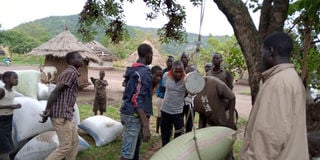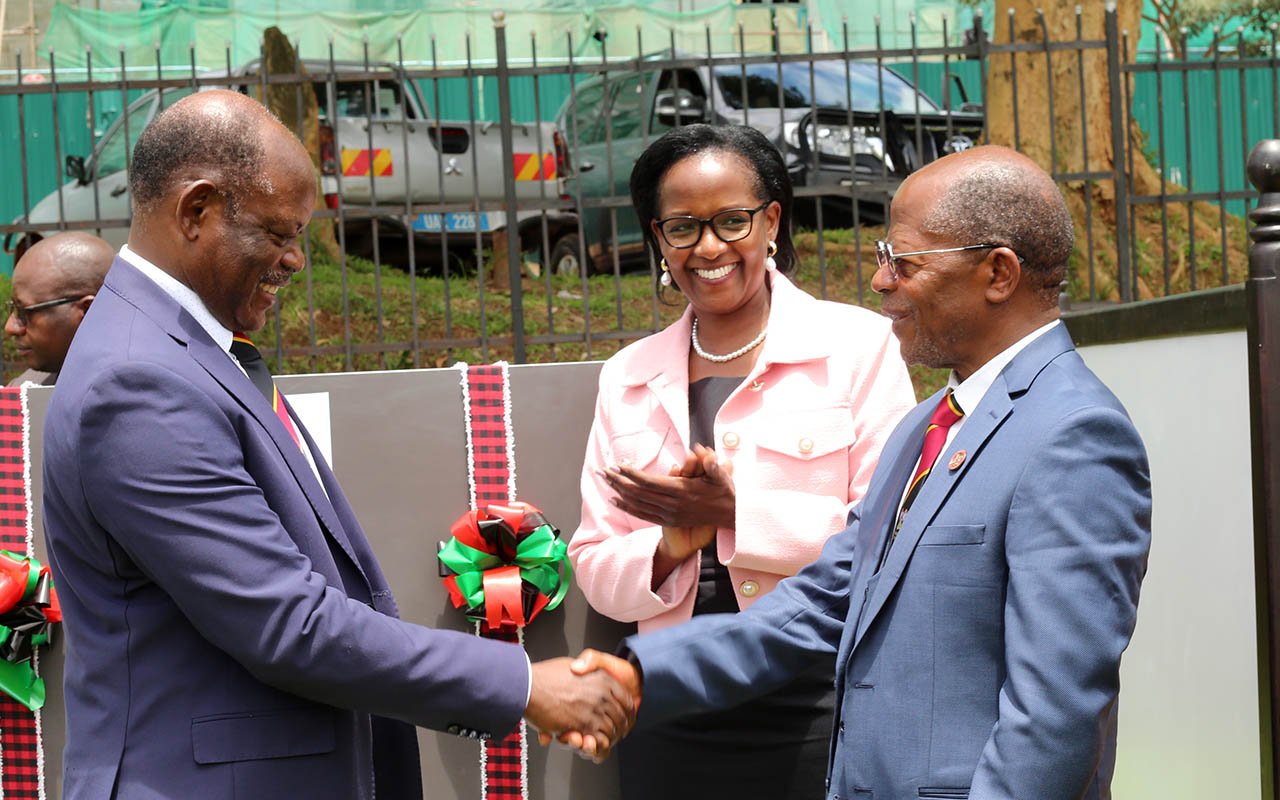Prime
Why Uganda is struggling to meet oil seeds demand

Farmers under their umbrella body Ngetta Tropical Holdings in Okwang Sub-county, Otuke District, weigh sunflower produce last week. PHOTOS BY TOBBIAS JOLLY OWINY
What you need to know:
- Uganda fulfils less than 30 percent of its current oil seeds demand despite efforts undertaken by the government to increase the production of palm oil.
The Russian-Ukraine war that broke out in February last year, and the earlier outbreak of the Covid-19 pandemic, highlightedthe country’s struggle to produce a commodity on high demand, oil seeds.
Whereas deliberate attempts have been made to persuade farmers to invest in oil seed sub-sector by growing crops from which cooking oil can be extracted and processed, the output has turned out exceedingly low, this publication has learnt.
Uganda fulfils less than 30 percent of its current oil seeds demand despite efforts undertaken by the government to increase the production of palm oil, including the Kalangala palm oil project.
Dr Samuel Mugasi, the National Agricultural Advisory Services (Naads) executive director, admits that there is a shortage of oil seeds and that the country is struggling to import edible (cooking) oil because its internal demands have excessively shot up.
“As a country, we are faced with a shortage that is affecting our local supplies, and as a result, the prices have been shooting up,” Dr Mugasi says.
“Uganda has been faced with a global shortage of seed oil affecting its local supplies and as a result, it is faced with shortages to meet the ever-growing demands,” Dr Mugasi says.
“This situation was worsened by the effects of Covid-19 and thereafter, we had the war in Ukraine,” he adds.
Government intervention
Last year, the government rolled out a five-year national oil seed programme, a post-Covid-19 oil seed subsidy scheme in which it intends to increase the production of oil seeds in the country, specifically in the north by providing subsidies to farmers.
Designed by the Agriculture ministry through Naads, the intervention focuses on Lango and Acholi sub-regions since they are the heart of oil seed production in the country.
To achieve this, a budget of Shs9b will be required annually to scale up production and support post-harvest handling and management of the project.
“The government provided Shs9b to Naads and we broke it down into two, we spent Shs6b on sunflowers, and Shs3b on soybeans,” Dr Charles Aben, the Naads crop development officer, says.
With the Shs6b spent on sunflowers, Naads procured 75,000 kg of sunflowers that were distributed to the farmers to be planted on 35,000 hectares.
The institution procured 500,000kg of the Maksoy-6N and Maksoy-3N variety of soybeans adequate to plant 20,000 hectares.
“We tracked the farmer cooperatives to whom we issued the oil seeds and discovered that the farmers realised approximately Shs40b after they sold the produce,” Dr Aben says.
To implement the programmes, Naads identified and profiled medium and large-scale farmers and cooperatives, through whom they implemented the intervention.
Later, a procurement process to identify registered seed companies to supply certified seeds for both soybean and sunflower to the identified farmers was triggered.
In the first season, 1,000 small-scale farmers and 40 large-scale farmers in Acholi and Lango sub-regions were given certified soybean and sunflower seeds.
Whereas the intervention has proven to be a critical catalyst in spurring economic development in the north, the harvests realised last year are yet to convince stakeholders that the country could soon be able to meet its domestic demand.
For example, while the country’s current consumption demand for oil seeds stands at 480,000 metric tonnes, the oil seed programme intends to push the country’s production capacity to 143,750 metric tonnes by adding another 63,750 metric tonnes to the current production of 80,000 metric tonnes for the next five years.

Farmers in Awei Sub-county, Alebtong District, tend to their sunflower garden in September last year.
Sunflower has an estimated oil content of about 30 percent, while soybean, on the other hand, has an estimated oil content of about 20 percent and an average protein content of 38 percent.
Uganda boasts of 104 vegetable oil processing factories, with an installed capacity of at least 3,000 metric tonnes per day, requiring 1,106,315,000kgs of grains at full capacity per year or 553,157,500kgs at half capacity per year.
Dr Aben, however, says one of the limiting factors for increased sunflower production in the country is relying on seed imports of highly productive hybrid varieties from South Africa, among other countries.
“Upon supporting the farmers with seeds, the next step is developing the infrastructure for bulking and marketing of oil seeds. We plan to support mechanised production of oil seeds by providing tractors and associated machinery, as well as improved seeds to oil seed producers,” Dr Aben says.
Dr Mugasi says they based their programme on a co-funding model in which government pays 70 percent and a farmer pays 30 percent of the input they receive.
Under the co-funding model, Naads gives sunflower and soybean seed subsidies to farmers where selected beneficiary farmers are required to contribute 30 percent, with the government meeting the remaining 70 percent of the total cost of planting.
The seed subsidy programme, Dr Mugasi says, aims at promoting access and use of hybrid seeds among smallholder farmers to increase oil seeds productivity in the implementing districts.
He says in their first attempt, they distributed 73,000kgs of hybrid sunflower seeds and 500,000kgs of improved soybean seed varieties, benefiting 48 large-scale farmers and 22 cooperative societies in the target districts.
“The scope of coverage of crops under the subsidy programme will vary over time, and in addition to sunflower and soybean, they will include Hass Avocado, cashew nuts and macadamia seedlings,” Dr Mugasi says.
Dr Mugasi, however, says only farmers who cleared the 30 percent demanded of them for the inputs will be supported.
Challenges
The oil seed farmers across the country are dependent on natural resources that are exposed and sensitive to climate change impacts, besides the farmer communities practicing predominantly rain-fed agriculture.
Meanwhile, Lt Gen Charles Otema Awany, one of the commercial farmers in Nwoya District, who benefitted from the programme, criticises Naads for the untimely delivery of the seeds.
“Timing was your biggest problem, at the end of the season, it is when you see planning materials arriving, and all that goes to waste. We were only lucky last season that the rains extended even into late December, otherwise there would have been a disaster,” Lt Gen Otema said.
Dr Tonny Obua from Makerere University’s Centre for Soybean Development and Improvement, says the huge potential of oil seed production in the country remains untapped despite the availability of all production factors.
He also reveals the centre and Naads are currently promoting six commercial varieties of soybeans across the country, including Maksoy-6N and Maksoy-3N.
The unfavourable market patterns characterised by low prices fronted by middlemen, Naads claims, have created a leeway for neighbouring Kenya to buy a reasonable fraction of Uganda’s oil seeds since they offer better prices.
“We have information that sometimes Kenya traders come and buy our oil seeds, and process them in Kenya. That’s an issue of price stability. That is why we are now fighting to mobilise cooperatives to build capacity to be able to buy this seeds and process them.”
Meanwhile, Ms Grace Freedom Kwiyocwiny, the State Minister for Northern Uganda, argues that subsistence farming characterised by limited innovation has hampered the capacity of local farmers to extensively engage in the commercial production of vegetable oil crops.
“We are talking about a well-connected farming system, through the value chain right from planting to the market. If we cannot do this and just cling to our traditional ways of agriculture, we shall miss out on the opportunities. The opportunities are now everywhere and we need to take them up,” she says.
But Mr Patrick Alip, the production officer for Lira District, blames late delivery of planting materials and price fluctuations for the low morale of farmers to engage in oil seed production.
“The seeds are delivered late and towards the end of the year, the prices come down. For example, in December, 2022, the price of sunflower was Shs900 per kilogramme, and this was quite low, at the moment, the price in the region is up to Shs1,500 and most cooperatives still have their grains in stock,” he says.




